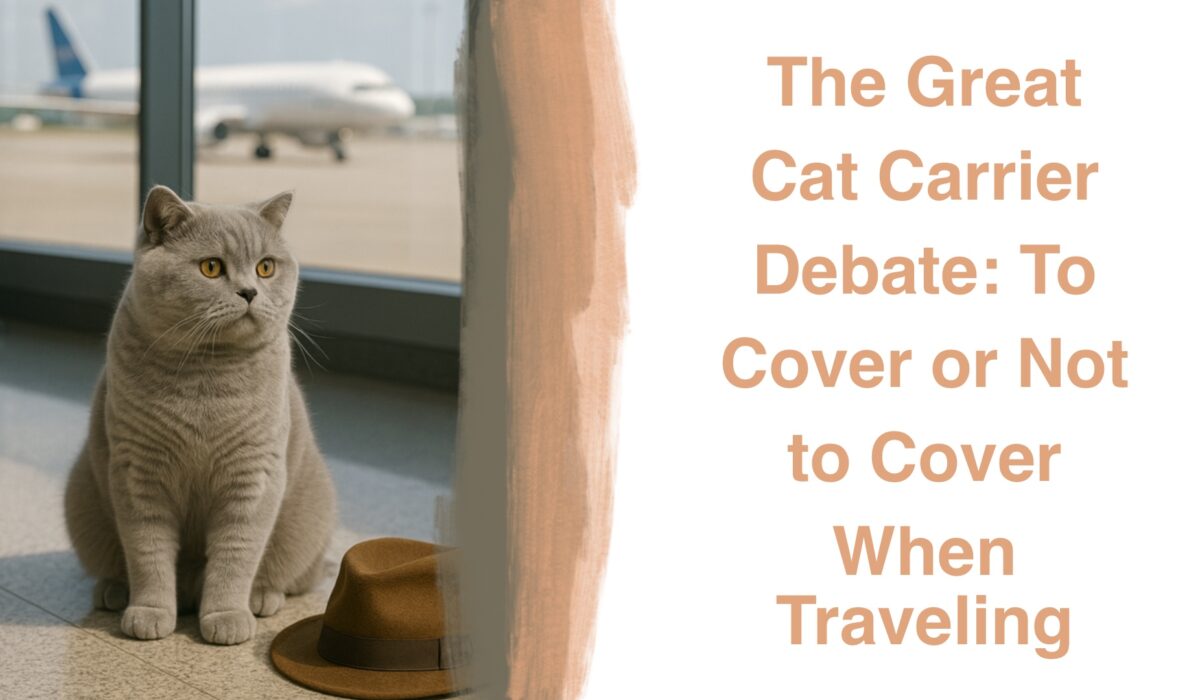The Great Cat Carrier Debate: To Cover or Not to Cover When Traveling
Solving one of pet parenting’s most mysterious questions
Walk into any pet store and ask about covering cat carriers during travel, and you’ll get about five different opinions from five different people. Some swear by keeping carriers covered for the entire journey, others insist cats need to see what’s happening, and plenty of cat owners are just winging it, hoping for the best.
So what’s the real deal? Should you cover your cat’s carrier when traveling, or is that just making things worse? The answer, like most things involving cats, is: it depends. But don’t worry – we’re going to break down everything you need to know to make the right choice for your specific feline travel companion.
Understanding Your Cat’s Perspective
Before we dive into covering strategies, let’s think about what travel feels like from your cat’s point of view. They’re trapped in a small space, everything smells different, there are weird noises and vibrations, and they have zero control over what’s happening. For a species that likes to survey their territory from high perches and always have an escape route planned, this is pretty much their worst nightmare.
This is where covering the carrier can help – or hurt, depending on your cat’s personality.
The Case for Covering: When Darkness is Your Friend
For Anxious or Easily Overstimulated Cats: Some cats get overwhelmed by all the visual stimulation during travel. Every passing car, new landscape, or unfamiliar face can ramp up their stress levels. A covered carrier creates a cozy, den-like environment that can help these cats feel more secure.
The “Out of Sight, Out of Mind” Effect: When cats can’t see what’s happening around them, many become calmer. It’s similar to how some birds calm down when their cages are covered – it signals that it’s time to rest and that they don’t need to be on high alert.
Better Sleep Quality: If you’re traveling long distances, a covered carrier can help your cat actually get some rest during the journey. The darkness triggers their natural sleep responses, which can make the time pass more quickly and comfortably.
Reduced Motion Sickness: Some cats get carsick from watching the world zoom by. A covered carrier eliminates the visual component of motion sickness, which can be especially helpful for cats prone to nausea.
The Case Against Covering: When Visibility Wins
For Curious or Confident Cats: Some cats actually find comfort in being able to see what’s happening. They want to keep an eye on you and monitor their surroundings. For these cats, a covered carrier can increase anxiety because they feel trapped and blind to potential threats.
Preventing Claustrophobia: Cats who are already nervous about being in a carrier might feel even more trapped when they can’t see out. The visual connection to the outside world can be reassuring, reminding them that they’re not permanently trapped.
Temperature and Airflow: A fully covered carrier can get stuffy, especially in warm weather or during summer travel. Cats regulate temperature differently than humans, and good airflow is crucial for their comfort.
Bonding and Reassurance: Being able to see you can be comforting for many cats. They can watch your face, hear your voice more clearly, and feel more connected to their favorite human during a stressful experience.
The Goldilocks Solution: Partial Covering
Here’s what many experienced cat travelers have discovered: the best approach is often somewhere in the middle. Instead of completely covering or leaving the carrier totally exposed, try partial covering strategies:
The Peek-a-Boo Method: Cover three sides of the carrier but leave the front partially open so your cat can see you and what’s directly ahead. This provides security while maintaining visual connection.
The Adjustable Approach: Start with the carrier more covered and gradually adjust based on your cat’s behavior. If they seem calmer with more coverage, add it. If they appear more stressed, remove some of the covering.
The Strategic Cover: Cover the carrier in a way that blocks the most stimulating views (like busy traffic or other animals) while leaving calmer views available (like the sky or interior of your car).
Reading Your Cat’s Signals
The best way to determine whether covering works for your cat is to pay attention to their behavior:
Signs That Covering is Helping:
- Your cat settles down and stops vocalizing
- They curl up and rest or sleep
- Panting or drooling decreases
- They stop trying to escape the carrier
Signs That Covering is Making Things Worse:
- Increased vocalization or crying
- More frantic attempts to get out
- Excessive panting or signs of overheating
- Your cat seems more agitated, not less
Practical Covering Tips
What to Use: A light blanket or towel works great – nothing too heavy that could restrict airflow. Some carriers come with covers designed specifically for travel. Avoid plastic or anything that doesn’t breathe.
How to Secure It: Make sure whatever you use to cover the carrier is securely attached and won’t slip or fall off during travel. Loose fabric can be dangerous if your cat gets tangled in it.
Climate Considerations: In hot weather, be extra cautious about covering carriers. Even with air conditioning, covered carriers can get warm quickly. In cold weather, a light cover can actually help keep your cat comfortable.
Practice at Home: Before traveling, experiment with covering your cat’s carrier at home. See how they react when it’s covered versus uncovered. This gives you valuable information without the added stress of actual travel.
Special Considerations for Different Types of Travel
Car Travel: You have more flexibility with car travel since you can easily adjust the covering based on your cat’s reactions. Start with partial covering and adjust as needed.
Air Travel: Airlines often have specific requirements about carrier covers, so check their policies. Generally, covers need to be easily removable for security checks.
Public Transportation: A covered carrier can help your cat feel more secure in busy, noisy environments like trains or buses, where there’s lots of human activity and unpredictable sounds.
The Multi-Cat Consideration
If you’re traveling with multiple cats, they might have different preferences. Don’t assume that what works for one will work for all. You might end up with one covered carrier and one uncovered, and that’s perfectly fine.
When to Ignore All the Rules
Sometimes cats surprise us. You might have a typically anxious cat who actually prefers to see everything during travel, or a confident cat who finds comfort in a covered carrier. Trust your instincts and your knowledge of your specific cat over any general rules.
The Bottom Line
The covering debate isn’t really about finding the one “right” answer – it’s about finding what works for your individual cat. Some cats travel better with covered carriers, others prefer the view, and many do best with a compromise approach that provides both security and visibility.
The key is being flexible and responsive to your cat’s needs. Start with what seems most logical based on your cat’s personality, but be prepared to adjust your strategy based on how they actually respond.
Remember, the goal isn’t to follow a perfect formula – it’s to help your cat feel as comfortable and secure as possible during travel. Whether that means a fully covered carrier, no cover at all, or something in between depends entirely on your unique feline travel companion.
And here’s a little secret: even the most experienced cat travelers sometimes get it wrong the first time. The difference is that they pay attention, adjust their approach, and get better at reading their cat’s needs over time. You will too.



